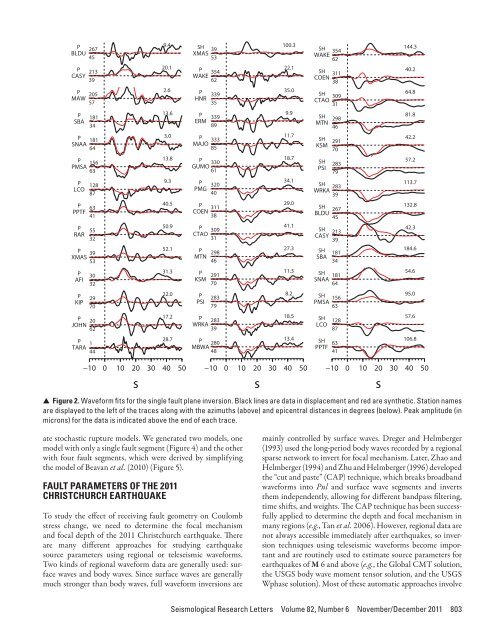Here - Stuff
Here - Stuff
Here - Stuff
You also want an ePaper? Increase the reach of your titles
YUMPU automatically turns print PDFs into web optimized ePapers that Google loves.
P 9.4267BLDU45P 20.1213CASY39P 2.6205MAW57P 13.6181SBA34P 3.0181SNAA64P 13.8156PMSA63P 9.3128LCO87P 40.563PPTF41P 50.955RAR32P 52.139XMAS53P 31.330AFI32P 22.029KIP70P 17.220JOHN62P 28.71TARA44−10 0 10 20 30 40 50sSH 100.339XMAS53P 22.1354WAKE62P 35.0339HNR35P 9.9339ERM89P 11.7333MAJO85P 18.7330GUMO61P 34.1320PMG40P 29.0311COEN38P 41.1309CTAO31P 27.3298MTN46P 11.3291KSM70P 8.2283PSI79P 18.5283WRKA39P 13.4280MBWA48−10 0 10 20 30 40 50sSH 144.3354WAKE62SH 40.2311COEN38SH 64.8309CTAO31SH 81.8298MTN46SH 42.2291KSM70SH 57.2283PSI79SH 113.7283WRKA39SH 132.8267BLDU45SH 42.3213CASY39SH 184.6181SBA34SH 54.6181SNAA64SH 95.0156PMSA63SH 57.6128LCO87SH 106.863PPTF41−10 0 10 20 30 40 50s▲ ▲ Figure 2. Waveform fits for the single fault plane inversion. Black lines are data in displacement and red are synthetic. Station namesare displayed to the left of the traces along with the azimuths (above) and epicentral distances in degrees (below). Peak amplitude (inmicrons) for the data is indicated above the end of each trace.ate stochastic rupture models. We generated two models, onemodel with only a single fault segment (Figure 4) and the otherwith four fault segments, which were derived by simplifyingthe model of Beavan et al. (2010) (Figure 5).FAULT PARAMETERS OF THE 2011CHRISTCHURCH EARTHQUAKETo study the effect of receiving fault geometry on Coulombstress change, we need to determine the focal mechanismand focal depth of the 2011 Christchurch earthquake. Thereare many different approaches for studying earthquakesource parameters using regional or teleseismic waveforms.Two kinds of regional waveform data are generally used: surfacewaves and body waves. Since surface waves are generallymuch stronger than body waves, full waveform inversions aremainly controlled by surface waves. Dreger and Helmberger(1993) used the long-period body waves recorded by a regionalsparse network to invert for focal mechanism. Later, Zhao andHelmberger (1994) and Zhu and Helmberger (1996) developedthe “cut and paste” (CAP) technique, which breaks broadbandwaveforms into Pnl and surface wave segments and invertsthem independently, allowing for different bandpass filtering,time shifts, and weights. The CAP technique has been successfullyapplied to determine the depth and focal mechanism inmany regions (e.g., Tan et al. 2006). However, regional data arenot always accessible immediately after earthquakes, so inversiontechniques using teleseismic waveforms become importantand are routinely used to estimate source parameters forearthquakes of M 6 and above (e.g., the Global CMT solution,the USGS body wave moment tensor solution, and the USGSWphase solution). Most of these automatic approaches involveSeismological Research Letters Volume 82, Number 6 November/December 2011 803
















